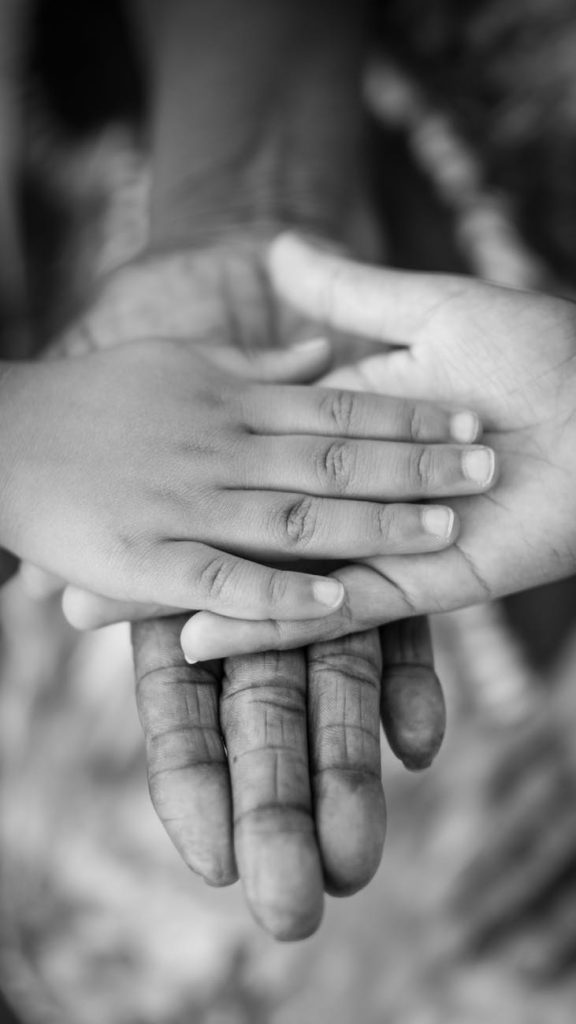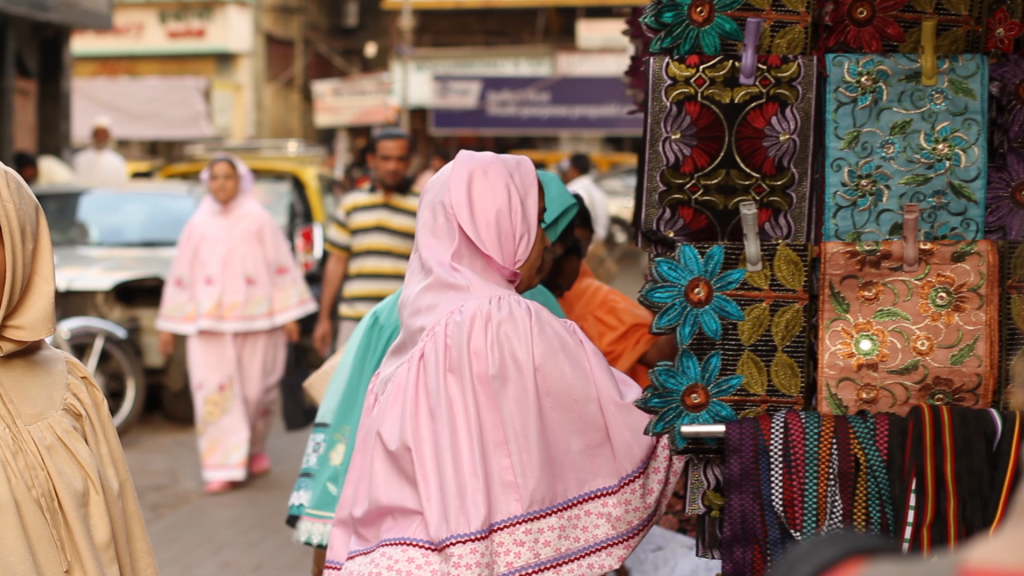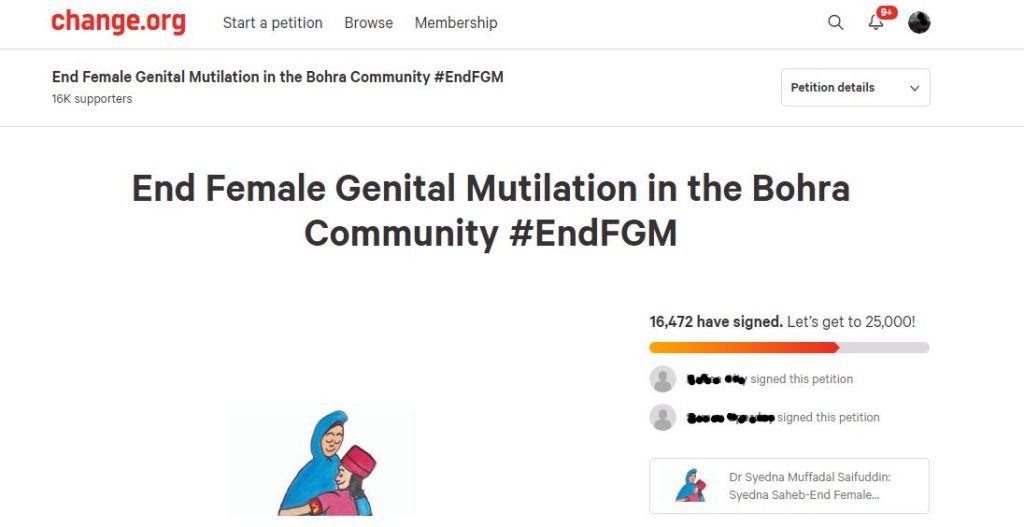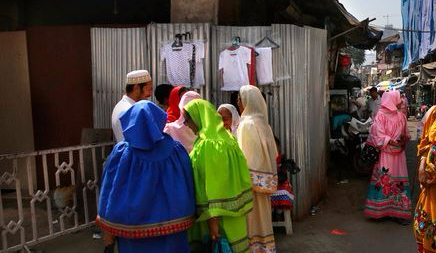My mother thought she was saving me with khafz

Photo Courtesy Of Kristin De Soto on Pexels.com By Rashida I can recall with crystal clear memory my mother taking me at around age 7 to a dilapidated old Chawl style building in a Bohra Mohalla in Bhendi Bazaar. My mom wore a dark orange saree with a green, white and light orange geometrical design. We climbed up broken wooden steps to go to the first floor on which there were several rooms with closed doors. We knocked on one of those doors and a lady quietly let us in. We sat down on the bare carpet and my mom greeted her with a salaam. The lady disappeared behind a curtained door. I know she came back with washed hands because my mom made me do the traditional salaam that we do to the elders, and her hands were wet and smelled of soap as I kissed them. The lady sat down across from us and I kneeled down to do the salaam. As I was finishing the salaam the lady pulled my pants down. My mom pulled me back, held my hands and covered my face with her sari and put her face in the sari folds so I could see her face, too. I felt a searing pain between my legs and I began to cry, and my mom made big scolding eyes (that’s how she always silenced me to show me her disapproval), and I reduced my crying to a slow whimper. I was very frightened and had no idea what was happening. The lady squeezed the tip of my clitoris firmly with a ball of cotton soaked in red mercurochrome as a final move. She told me to keep that ball of cotton in place and not to touch it until it remained stuck to my clitoris. My pants were pulled up and I sat in my mom’s lap sobbing. The lady appeared again from behind the curtained door and was drying her hands nowon a napkin. She pried open my clenched fist andforced two Parle G glucose biscuits into it, and I clutched them while clinging to my mom in a petrified state with the other hand. My Mom did salaam to the lady with an envelope filled with money and we began to leave. I walked out very slowly holding my mother’s hand and we began to descend the staircase. My mom picked me up and carried me down. I remember that moment most vividly today because my mom had stopped carrying me since I was so tall and grown up. I was relieved and happy that she was carrying me because she had not done that in a very long time. Mom then called for a passing taxi cab. We took taxicabs only for special occasions like a wedding or if we had too many people in a group. I looked up and asked her, “Mummy, we are going in a taxicab to uncle’s home? It is only half full?” And she just smiled and asked me to eat the biscuits. The taxicab drove us to my uncle’s home (my mom’s brother) and as I was playing outside a few hours later, I overheard my mom talking quietly to my aunts (her sister and sister-in-law). “Oh, I thought Rashida would cry and scream,” she said. “She was so good, and look she is already running around. You cannot even tell it has happened. I was told she would shout and kick her feet. But she is all okay.” Mom said she was relieved that the deed was done. Later that afternoon, I told my mom about the bloody ball of cotton that was still loose and lying around in my underwear and she threw it away for me. My brothers were playing around and my 11-year-old brother asked me, “What happened to you? Did somebody do something to you?” He must have overheard the adults talking. He does not remember this incident. I just ran away too scared to answer. The community is getting regressive and male-dominated and under the influence of clergy clout. Despite FGM/C education, the social pressure to follow the diktats is palpable, real and fearful. Social boycott and fear of Laanat holds back the followers in shackles of complete submission. The issue of equality is a blatant cover-up. The clitoral hood is clearly called “Haram ni Boti” in all sermons and all discussions that are held privately in the community. “This piece of flesh has to be taken out or the girl will be sexually promiscuous.” The Sabak or lessons given by the priests and their wives at the mosques, preach to the parents and especially to the mothers that “your daughters will have an extramarital affair or pre-marital sex if you do not do this. Save your family’s name by doing khafz.” I do not hate my mother for doing FGM/C to me. She was an educated woman of her times with a BSc, B.Ed., and an M.S. in Chemistry. She was a teacher and retired as principal of her school. She was a victim of this procedure, too. My mother thought she was saving me. I am sure there was a lot of social pressure from the family and community. My only conversation with her was a casual single comment she uttered as she overheard my friend complaining about health issues her young daughters were facing. My mom quietly said, “We do a procedure to our girls that prevents urinary tract infections in young girls.” I was embarrassed and knew she was referring to FGM/C. So I said, “No, mom, that is wrong and not true!” Mom just walked away. My friend had no idea what we were talking about. We had no conversation about FGM/C or what happened to me at all thereafter. My mom passed away very young at 61 years of age and I will never have my questions answered. I love my
I still don’t get why my mom took me there: A Bohra survivor of female genital cutting speaks out

Photo Courtesy Of luizclas on Pexels.com By Anonymous Country of Residence: India Age: 31 Many communities across the world continue to practice female genital mutilation (FGM). In India, it’s mainly the Bohras, a sub-sect of Shias who practice FGM, also known as khatna. The clitoris and/or labia of little girls is cut or mutilated with the belief that it would curb their sexual desires and stop premarital sex. Many of the women performing khatna have no medical qualifications and are typically women who have learned to perform the cutting from their ancestors. Many midwives perform this in the name of salwaat (or blessings). But they hardly know why they are doing this. When you are a child, your parents and grandparents are people you trust the most. They tell you about not interacting with strangers or not allowing any stranger to touch you in your private areas. Still it’s your close family who takes you for khatna, allowing a complete stranger to touch you inappropriately and cut your clitoris. It’s like being betrayed by the people you believe in and trust the most. I am writing this to share my experience. At the age of six, I was taken out by my mom like any normal day, although most of my childhood memories haven’t made as strong of an impact as this one. We reached a stranger’s place. I went inside the house with my mom. My trousers were removed and then I was told to lie down. I felt extreme pain in my private area. I could feel, although I was instructed to look at the ceiling. I was doing that, and within a few minutes, my mom said, let’s leave. I was still experiencing the pain. The pain was terrible when I urinated. I never really understood why my mom took me there. I still don’t get it. Why do something terrible to a girl which can leave a psychological scar in their mind which never heals? In fact, when I became a teenager, I asked my mom why she allowed this khatna to happen to me. The answer I got was tradition, and that it prevents cancer. Then the other question which immediately popped up for me was, “Why only us?” Later I found out it’s mostly done to curb the sexual desire of girls. This practice ultimately leads the girls to mistrust the people they are supposed to trust the most. It’s not in that instant you realize what happened, but gradually the memory becomes too vivid. Just because something is practiced for generations doesn’t mean it should go on without questioning its existence. People have to change their thinking about existing rules and guidelines to follow in the name of customs. The problem is that if you come out of the shadows and rebel, you may be thought of as an outcast. It’s not us we are afraid of but people we know. Family and friends will be treated differently as well. I believe in taking small steps of at least opening up about what you feel will help you to let go of that which you are suppressing. That will ultimately will give you the confidence of coming out of the shadows and facing the light.
Wrestling with trust and fear in regard to female genital mutilation

By Farzana Esmaeel Country of Residence: United Arab Emirates Trust and fear are two emotions that have an interesting correlation to input and output of human behavior. One emotion, trust, establishes safety and comfort for individuals whilst the other, fear, displaces the very premise of safety and comfort. At the age of 7, you don’t articulate emotions; you feel them. And your mother is your beacon of trust. She loves you, comforts you, cares for you and sacrifices for you. Then, when trust is removed, it’s only natural to feel extreme pain and deceit at her hands the most. My sister and I were taken to a dilapidated, dimly lit building at the far end of the city on the pretext that we were going to meet an aunt for a check-up. At the tender age of 7 when mum tells you we are going for a check up you don’t appreciate entirely its meaning, and at the time it meant to me that we were going to see a doctor. What followed was unprecedented, and a memory that will be etched in our minds forever. Sadly. The pain was too much to bear as 30 years ago, female genital mutilation (FGM) in the Dawoodi Bohra community was generally more practiced under callous and less “sterile” ways. (Yet, even today, when it is practiced by licensed white coat doctors under more hygienic conditions, it doesn’t make the practice correct.) The overarching feeling I took after my experience 30 years ago was deceit. My mother is a simple, non-confrontational, less informed person, who at the time of my sister and my cutting, played into the hands of a community (mindset) that propagates fear: fear of being ‘ostracized’ for not having FGM done, fear of her daughters being ‘impure’, fear of standing up against cultural norms and practices. Though today, this same woman hasn’t once told either of her daughters to carry out this inhumane practice on her granddaughters. She now understands the pain and futility of it all. FGM is a practice entrenched with ‘fear,’ stripping human ‘trust,’ and inculcating in young girls early on to be apologetic about their sexuality and their desires. It is on us to be the change. We must question this violation of human rights and ensure that we raise our voices against this harmful practice, not just for our daughters, but the many more daughters all around us.
My decision as a mother to not cut my daughters

By Masuma Kothari Country of Residence: United Kingdom A vivid memory of my cut has lived through so many years that I can recall the entire act. This experience always intrigued me and it did lead me to the insights of child psychology as to how tender a 7-year-old is. Even though my personal experience was not very excruciating, I clearly remember the sense of betrayal, and it never went away. I was never convinced with the benefits theory that was proclaimed, and honestly, nobody really knew at a deeper level the real reason to follow this practice when I sought guidance. Because of the social influence, it was apparent that herd mentality, unexposed details, unquestioned thoughts promoted this practice. When my elder daughter was near the age, I had to figure out for myself if my daughter should also be cut. It felt as if I had Godlike power to alter something natural belonging to my daughter’s body forever, and that did not feel right. For me, the decision was a chaotic fight between the cultural beliefs and the scientific quest. I reached out to a few of my doctor family members to understand if there was any scientific aspect. All of them discouraged the practice. That is when the light in my heart beamed strong. I chose courage and discussed this openly within my group of Bohra friends. Surprisingly, I found most of the women were also against it and this strengthened my defiance! In fact, my mother secretly regretted having the practice done to me, too. I was sure I did not want to take away what God had bestowed on my daughters. With this clarity, I announced it to my family that we won’t be conducting this on our daughters. One additional powerful advantage was that we resided in the United Kingdom. Since it is a criminal offence here, it was an easy argument to assure a few of our noisy family members back in India. Because we as parents were strong, nobody really questioned or bothered to enforce this. It was simply about standing up for what we thought to be correct. My husband was firm from day one that he was not willing to get this done for our daughters, yet he had given me the ownership of making this decision in case I was convinced that it had to be done. My decision scale had a chunky weight on anti-FGM, which was also a major influence in my decision to not cut my daughters. There is absolutely no need to do this. If you are a parent struggling with the obligation to have this done, just say no to this age-old trauma-enabling practice and move on guilt- free with loud pride that you have made the right choice.
Why female genital cutting still continues: Exploring the reasons behind its sustenance

By Debangana Chatterjee The reasons why female genital cutting (FGC) continues are multifarious and overlapping. Complex and interconnected sets of reasons for FGC are woven into the faiths of the communities. Thus, faith becomes the genesis of these reasons, making FGC considered to be beneficial by the communities. These reasons can be broadly grouped as traditional, socio-cultural, sexual and hygienic, but are also closely connected with each other: • Traditional: According to Anika Rahman and Nahid Toubia, authors of Female Genital Mutilation: A Guide to Laws and Policies Worldwide, for a number of communities FGC is considered a rite of passage to womanhood and is driven by traditional beliefs. This womanhood is often believed to add to the marriageability of the circumcised women. The practice is carried forward by the women belonging to these communities for generations. Though there is no direct mention of the practice in the Quran, hadiths became a traditional source of its justification. At this juncture of faith, tradition paves the way for the socio-cultural reasons behind the practice. Dogon people of Mali / Photo by Jenny Cordle • Socio-Cultural: Among practicing communities, the practice in many ways becomes a hallmark of communal identification, as it garners acceptability and induces social conformity within communities. Some communities are also believed to have adopted FGC due to contiguous cultural influences. Considerable communal pressure for performing FGC involves the threat of social ostracism. Local structures of authoritative forces ensure the continuation of the practice by implementing these measures on the basis of their social norms. As the practice remains one of the sole sources of income for traditional cutters, economic reasons as a corollary to the socio-cultural ones also drive the practice. • Sexual: FGC is believed to control women’s sexual behaviour. There are claims of it restricting women’s sexual urges. Extreme procedures, such as infibulation, are used as mechanisms to keep women’s premarital virginity and marital fidelity in check. Due to the extreme pain that intercourse typically causes in infibulated women, women do not get sexual pleasure. FGC is frequently claimed to be used as an impediment toward the “promiscuous” nature of women. • Hygienic: Many believe the removal of a part of female genitalia amounts to cleanliness. In this regard, cleanliness in the hygienic sense results in physical purity, which is ultimately believed to pave the way for spiritual purity. This understanding of purity becomes closely entangled with the cultural beliefs of femininity and modesty. Despite creating this broad rubric of prominent reasons, the reasons noticeably overlap and are distinct in manifestation when it comes to the customs of specific communities. In certain cases, there are multiple driving factors, whereas in other cases the manifestations of these reasons are even more particularistic. For example, as Laurenti Magesa, the author of African Religion: The Moral Traditions of Abundant Life, explains among the Kikiyu people of Kenya, FGC is celebrated as a mark of womanhood. Among the Bambuti and Thonga community, during the procedure girls are shown no mercy and are treated with ruthlessness as a sign of their gallantry and bravery. Among certain groups in Tanzania and Somaliland, infibulation is believed to form a “chastity belt” around the skin of female genitalia. Magesa underlines a few reasons for FGC specific to diverse African communities. Primarily, it is conceived as a mark of valour and of enduring physical pain within the community. This pain is thought to teach girls about sacrifice for the community as well as a sense of belonging. Finally, many believe that the practice strengthens the community bond among generations and knits the community together. Among many communities, girls are prepared for the practice through an initiation ceremony. But among the Zaramo people of Tanzania, the girl is secluded for a substantial period after circumcision. During this particular period, girls are trained and informed about obedience in general, conformity to social norms, fertility, and childbirth. According to Kouba and Muasher, the Dogon and Bambara people of Mali believe that a child, born with both male and female souls, is also possessed by wanzo. Wanzo is believed to be evil residing in both the male and female genitalia and thus, cutting as a process helps in getting rid of wanzo. In India, Bohra Muslims are evidentially the most significant community practicing FGC, which is termed as khafz. As per the believers of the community, Da’i al-Mutlaq, also known as Da’i, hold an authoritative, infallible status in the community. Da’i or Syedna (as referred to by the Dawoodi Bohras) is considered to be the sovereign leader, spiritual guardian and temporal guide of the community. As Da’i considers Daim-ul-Islam as the binding religious text for the Bohras, diktats of the text are taken as truth by the community members. It is a text written by Al-Qadi al-Nu’man who served from the 11th to the 14th Imam of the Shia lineage. In this text, the Prophet is believed to advise for a simple cut of women’s clitoral skin as this assigns purity on women and may make them more “beloved by their husbands”. The community mostly puts forward religious reasons based on their faiths in support of the practice. There are multiple narratives justifying the practice among the Bohra community members. A substantial number of community members believe that the practice tames women’s sexual urges and preserves modesty. Many claim that the nicking of the prepuce helps increase women’s sexual pleasure by exposing the tip of the clitoral hood. In this regard, it is often put forward in the same breath as the genital altercation procedures of clitoral un-hooding. Similar narratives espouse that the practice induces purity among women. For them, if it is well within the rights of Muslim men to be spiritually pure by performing circumcision, it is unjustifiable to prevent women from attaining equivalent purity. In fact, in certain cases, there are convictions by the pro-FGC Bohras toward the futuristic scientific revelations about khafz’s perceived benefits. When faith becomes a part of people’s everyday life, life needs
A response to the letter written by Tasneem Yunus Burhani, Mubaraka Tambawala, Farida Mustafa Hussain, Fatemah Hussain, and Shakera Bohra published in Detroit News

By Umme Kulsoom Arif In response to your letter published in The Detroit News, “Dawoodi Bohra Women of Detroit speak up,” I write to you as a woman who grew up in a part of the Dawoodi Bohra community, just like you. I am also a woman of faith and education, a woman who loves her country as well as her Dawoodi Bohra community, who balances religion and patriotism in a trying, divisive time. And just like you, I am frustrated and saddened by the propaganda and misinformation that has spread surrounding the case of Dr. Jumana Nagarwala because I too am a survivor. A survivor of a harmful practice that violated my human rights, robbed me of my personal integrity, and — in punishing me for my own femininity — left me permanently scarred, both mentally and physically: khaftz. You claim that khaftz “in no way can be defined as female genital mutilation,” but do you know what FGM even is? The World Health Organization defines FGM/C as “all procedures that involve partial or total removal of the external female genitalia, or other injury to the female genital organs for non-medical reasons.” So educate me, then — what is the medical reason for khaftz? Why must it be done? Why must a girl be lied to, held down, or drugged so that a blade can be taken to her genitals and a part of her clitoris sliced away? You call the procedure “harmless,” so I ask you — where does the harm begin in your minds? Where do you draw the line between the “ritual” you defend and the “more barbaric practices from around the world” you claim to condemn? Is it not harmful to deny your daughter the right to her own bodily autonomy? Is it not harmful to violate her right to be free of torture and degrading treatment and to teach her that her body is “wrong” and must be surgically altered based on the words of religious men? The Quran does not ask this of us, so I ask you — who does? When countries around the world — including the United States — have signed human rights treaties both condemning and outlawing all forms of FGM, who demands that our daughters be subjected to a cutting or scraping without their consent and with no medical reasoning behind it? Though you claim to be patriotic Americans who follow all the laws of the land, you challenge a law meant to protect the most vulnerable members of the country’s population — its children. How can you in good conscience, claim that khaftz is “much more akin to a body piercing” when a child would never consider getting a piercing in such a sensitive area? Many of you are lucky to have suffered no consequences — physically or mentally — from khaftz, but your experiences are far from universal. You lie to yourselves when you purport to be representative of all the survivors of the khaftz. You lie to your daughters when you claim that there are no negative effects to the practice. You do a disservice to your community when you hide the truth of this harmful form of gender-based violence behind pleas for tolerance and claims of political persecution. By claiming that your experiences are universal and by defending this harmful practice, you have a direct hand in perpetuating violence against women. Is that the future of the Dawoodi Bohra community? A future where we must look our children in the eyes and tell them that they have no ownership of their bodies? A future where our daughters must be subjected to sexual trauma and placed at risk for future infection, for future complications in childbirth, or for chronic pain in a most sensitive area? The Dawoodi Bohra community cannot adhere to archaic violence in the name of tradition. The world around us has changed, and today we know more about our bodies and the consequences of our actions than we ever did. We must grow as people, as a community. We must come together to help, not harm. You may be educated women, but you blind yourself to the true nature of khaftz and its harm. You beg for tolerance and understanding but you do not try to understand the pain you inflict on your daughters when you have them cut. I beg you to take the time to listen to women the world over who have been harmed by khaftz. Read also “Other Views on FGM.”
The Legal Side of Khatna or Female Genital Cutting

By Priya Ahluwalia Priya is a 22-year-old clinical psychology student at Tata Institute of Social Sciences – Mumbai. She is passionate about mental health, photography and writing. She is currently conducting research on the individual experience of khatna and its effects. Read her other articles in this series: Khatna Research in Mumbai. Female Genital Cutting or khatna or khafz, as it is also called in the Bohra community, involves cutting or removal of the external female genitalia. Khatna has no known health benefits, but does have well-documented complications, which range from severe pain, excessive bleeding, and scar tissue to frequent infections. The movement against khatna in India perhaps began in the early 1990s with Rehana Ghadially’s paper, “All for Izzat”, which attempted to identify the key reasons for why khatna was performed in India. However, the movement only gained momentum in 2011, when the first online petition was filed against it anonymously. The online campaign triggered a barrage of women coming forward with their own stories of trauma caused by khatna. It further fueled both online petitions as well as an onground movement. Within the Indian context of the Dawoodi Bohra community, the majority of the cases of khatna constitute Type 1, also referred to as clitoridectomy, which involves either partial or full removal of the clitoris, or the fold of skin known as the prepuce, covering it. Interestingly, there are many men and women who support khatna. From a psychological viewpoint, it may be rooted in the cognitive dissonance theory. Men and women of the Dawoodi Bohra community have been indoctrinated to believe that khatna is an essential religious obligation, and the will of God is not to be questioned. The online campaigns provide women in the Bohra community an alternative narrative, which may be in direct conflict with their existing beliefs. This conflict has created a lot of anxiety and conversations which have led to the movement gathering momentum, eventually catching the attention of the Indian government. The uphill legal battle saw the government oscillating between supporting and opposing the movement. In May of 2017, the Ministry of Women and Child Development declared full support for survivors, deeming the practice a criminal offence with prosecution possible under the guidelines of POCSO (2012). The ministry requested the community to voluntarily take action to stop it. If it failed, the government would seek to implement a law to end it. In December of 2017, the ministry withdrew from its position, citing lack of empirical evidence despite proof from Sahiyo’s landmark study, which revealed that 80% of Bohra women globally have undergone khatna. Although the rejection from the government was disheartening, the momentum of the movement has not faltered. Organizations such as Sahiyo and WeSpeakOut continue to provide crucial support for survivors to rally in solidarity. Several countries in Africa, as well as the United States and Australia, have made consistent and successful attempts to end female genital cutting. To understand how this has been possible, we must examine how the socio-economic structure of these countries has played an integral role in their success. Several of these countries may have high literacy rates, greater awareness of their rights and a more conducive environment for survivors to speak out. The Bohra community aspect is crucial to understanding the Indian government’s hesitancy to pass a law. Although India is a signatory to several of the United Nations and World Health Organization conventions which view khatna as a human rights violation, it comes under the purview of existing Indian legislation, such as article 319 and 320 of the IPC and POCSO. No separate law has been passed against FGC until now. Things looked hopeful when the PIL filed against FGM/C was to be heard by the five-judge bench in the India Supreme Court. The decision initially seemed to swing in favor of banning the practice, as the judges referred to it as a violation of the rights of the girl child. The judges questioned how the violation of the “bodily integrity” of the child could be an essential practice of a religion, asserting that right to religious freedom does not negate other fundamental rights of the individual. Despite overwhelming support, the judges later backtracked, deferring to a constitutional bench to decide on the matters of religious rights and freedom. It was the most crushing setback for the movement. Initially, I wondered what the hesitancy was in declaring khatna as a human rights violation. Later, I realized that the hesitancy was due to the political context and not the practice itself. Family and religion are the founding threads of our Indian community, and khatna is so intricately woven within these threads. Family and religion are our sources of identity, and since India is a collectivist society our ideas, beliefs in practices such as khatna are rooted in a collective experience, rather than an individual’s. Thus, attempting to end khatna risks unraveling the whole moral power structure of the country. Initially, it will begin with the Bohra community, but it may create a ripple effect across the country within other communities and religions. The moral thread of India is religion, and religion dictates our gender roles. If khatna is being questioned, we are unraveling this power structure by questioning the clergy’s teachings, and instead seeking the truth for ourselves by reading the religious scriptures whose access has unduly only been given to men for so long. Perhaps, with this newfound knowledge, our perception of the world will shift, leading to a destabilization of the existing structure and establishment of a new order with women in power. Change is just around the corner. Although the law is the first concrete step toward ending khatna, it is also a double-edged sword with unintended consequences. The law has the potential to push the practice further underground. The more discreetly cutting is done, the more difficult it would become to track it. Furthermore, the law would bring into question the perpetrators of the crime. Is it parents, midwives,
Examining Female Genital Cutting and Intersectionality

By a Bohra The recent dropping of charges against Dr. Jumana Nagarwala, who is accused of performing female genital cutting on underage girls in the United States, on a constitutional technicality rather than perceived criminality, solidified my thinking about the relationship between power and oppression. This thought was first introduced to me by Irfan Engineer, the son of Asghar Ali Engineer, a prominent activist who engaged in a decades-long battle with the Bohra orthodoxy over community reform. Irfan, a successful activist in his own right, described to me the relationship between the Indian state and the Bohra clergy. As long as the clergy declared electoral allegiance to the government, the state would turn a blind eye to the clergy’s authoritarian rule over the Bohra community. This relationship was made visible by the government’s reversal of its support for a national law against FGC, shortly after Prime Minister Modi (dis)graced the stage at one of this year’s Bohra Ashura sermons. Modi extolled the virtues of the economically and educationally advanced Bohras, who were allegedly setting a great example for their impoverished and persecuted Muslim countrymen. Seeing Modi on stage, Bohra Muslims could almost forget the carnage inflicted in Gujarat in 2002, and Modi’s rampant Islamophobia since. The Bohra community has probably been shielded from Islamophobic violence because of the clergy’s close relationship with the ruling right-wing BJP (Bharatiya Janata Party) and its ideological parent, the RSS (Rashtriya Swayamsevak Sangh). Even I was willing to overlook the fact that the Indian government’s attempt at criminalising FGC was based more on criminalising Muslims rather than empowering women. Yet, I thought, maybe the ends will justify the means. I was wrong. Modi’s relationship with the Bohra clergy makes it clear that we cannot rely on the Indian government to end FGC in our community. Even if the Supreme Court rules in favour of criminalising FGC, we can be certain that the government will do nothing to enforce the ruling. This violent relationship between the state and vulnerable women is not restricted to the Indian context. I am reminded of the first FGC case to be prosecuted in Australia, where three people were sent to jail after being proven guilty. An appeals court, however, acquitted them all after new evidence was released that showed that “the tip of the clitoris was still visible in each girl”. The reduction of the emotional, physical and ideological violence of FGC down to a visual assessment of a pinch of skin shows the weakness of even Western legal systems in protecting marginalised women. It is similar to the victim blaming that is still a routine in rape trials, and the inability of the state to protect women who report honour-based violence. Whether through negligence or structural misogyny, Western and non-Western governments have failed women. If the government is not an ally, could I turn instead to ‘reformists’ within my own community? I am in contact with certain Bohras who are not part of the mainstream community, and reject the leadership of the current clergy. They believe that the current leaders have deviated from the true message of the Imams, and that we must educate ourselves by going back to the original sources of our tradition. I thought that this group of people (mostly men), espousing rationality and critical inquiry, would immediately be against FGC. I was wrong. The emphasis on going back to the original sources means that they accept, uncritically, the infamous book by Qadi Numan (Da’im Al Islam) that advocates for girls to be ‘circumcised’ once they are older than 7 years old. Any debate, often started by the few women in the WhatsApp group, about the necessity of this practice in our modern context, or even about the issue of consent, is shut down. I thought that a shared experience of living under a tyrannical religious clergy might force these men to be more critical of existing power structures and hear the voices of marginalised women. Once again, I was wrong. I learned that the patriarchy, embodied by these ‘reformist’ men, can never be leveraged to end violence against women. I learned that it is not worth compromising my core values in order to ally with fickle powers that do not center marginalised voices and their struggles. Real change can only happen from the ground up. This is why the work done by organisations such as Sahiyo is vital. By reaching out to individuals, and creating a space to share our stories, Sahiyo creates sustainable change within the community, and rebalances the power structures that exist within.
Sign the #EndFGM petition on change.org

A new change.org petition calling for an end to Female Genital Cutting in the Bohra community was started in September by Ranjana Sehgal and Umi Saran. The petition is addressed to Dr. Syedna Mufaddal Saifuddin, the spiritual leader of the Bohra community, and was started in response to the Syedna’s visit to Indore to give sermons during the first ten holy days of Muharram. As the petition mentions, “Although the matter is already in the Apex Court if the directive to end FGM comes from the spiritual head of the Bohra community, it will be easier to put an end to this violent practice. The Government of India’s WCD Ministry has said that FGM is in clear contravention of our laws, the Indian Penal Code and Protection of Children from Sexual Offences (POCSO).” Over 16,000 supporters have already signed, and the campaign’s next goal is reaching 25,000 signatures. If you would like to support by signing, click here.
Is the Dawoodi Bohra community truly as progressive as it claims to be?

By Saleha Country of Residence: CanadaAge: 45 Having lived in South-East Asia, and being exposed to multiple races and cultures, I grew up in a very open-minded family. As a child, my family and I occasionally went to the local Bohra mosque to socialize with others in the community. I loved going to the “masjid” – there I got a chance to meet my best friend and also eat delicious Bohri food. It was wonderful to see all the aunties dressed up in “onna ghagra” which are colourful skirts with matching chiffon scarves draped around the head. After the prayers, everyone congregated outside and chatted into the late hours of the night. Then suddenly in the early 90s it all changed. The upper echelons of the Bohra clergy instated new rules. The progressive Dawoodi Bohras were no more; instead, women were forced to wear a form of hijab called “rida” and men were made to sport a beard, wear a kurta, and “topi” or a cap on their heads. The clergy, headed by the Syedna, began to exert control over everything. Permission from Syedna was required not only for religious matters but in daily life as well. For example, permission was needed to start a business, get married or even to be buried. Female Genital Cutting or khatna was deemed necessary, even though that act of it is not prescribed in the Koran. If any of the rules were not followed, or if you protested and spoke against them, you were excommunicated or threatened to be. You’d lose all your ties to friends and family forever. I can never forget the awful day, when I was seven, while on a holiday in India, my aunt asked me to go shopping with her. She took me to a dingy place where a Bohri man and woman took me inside. They asked me to undress waist down, and when I protested, the man held my hands while the woman removed my jeans and underwear and forced me to lie down. I saw the man take out a blade and I struggled and screamed for help, while they proceeded to cut me. I lay bleeding on the floor, unable to comprehend what had happened to me. It was horrific, painful, and demeaning. I hated what was done to me. I hated that my mom was not there. I was angry at my aunt for allowing them to hurt me. I remember that experience vividly and to this day I am infuriated that I had to go through this ordeal as a child in the name of religion. While the majority of the Muslim communities around the world have spoken against this, the Dawoodi Bohra religious authorities urge continuing FGC under the guise of cleanliness. The worst part is that some women push this practise on vulnerable children too young to give consent, instead of protecting them as adults should. It was a difficult time for me. Having grown up with all the freedom in the world, it was suddenly being taken away from me and I grew cynical of my Bohra culture and wanted no part of it. Today, I am happy I decided to leave the fold. It was not hard to leave. In fact, it was liberating. I was not comfortable with the more rigorous path that my community was taking. I am sure there are many other Bohri people out there who are quietly questioning many of the beliefs handed down to them – some so silly, useless, and others very damaging – Bohris must refrain from using Western toilets; Bohris cannot host or attend wedding functions in secular, non-Bohra venues; brides can apply mehndi only an inch below the wrist and cannot hold the traditional “haldi” functions; and all Bohris must carry a RFID photo ID which will monitor attendance to the mosque. Humanity has achieved such remarkable progress. We have ventured into space, developed cloning and gene editing technologies, and most importantly, the Internet has resulted in globalization and interconnection between various cultures and communities. In this light, I wonder why we are still talking about FGC and the right to choose to do it to our daughters in this day and age? I am thankful that organizations like Sahiyo and We Speak Out have become a voice for children who are being hurt in the name of religion. I look at my children and I see the most informed, connected, and progressive generation. Imposing impractical, harmful religious rules such as continuing FGM on such a generation will only drive them further from our culture. More and more Bohri women and men are speaking out against this harmful practise because whenever religion becomes too rigid, too corrupt, it begins to crack. My hope is that our community can find the strength to break free from all the rigid practices and once again become the most progressive community among the Muslims.
